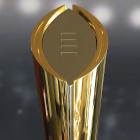GRAPEVINE, Texas -- The College Football Playoff Rankings return weekly beginning on Tuesday, Nov. 1. For two years, I have sometimes mocked these weekly mock rankings -- not because of the actual selections (well, usually not) but due to them even existing in the first place.
Yes, it gives us something to talk about and, more importantly, provides ESPN with Tuesday programming to justify how much money it's spending on the playoff. But weekly rankings place an enormous time demand on the CFP Selection Committee members to produce make-believe results that could box them in a corner (see the great TCU-Baylor debate of 2014).
And that's how I felt before going through the process myself. After participating in a mock CFP Selection Committee in early October, I'm even more impressed enough people sign up for this weekly committee task. No wonder the CFP has yet to keep 13 members as planned in any year.
Imagine you're a current athletic director. You fly halfway across the country to sit in a conference room at the Gaylord Texan Hotel to talk football and make vote after vote each week over the final five weeks of the season. Only three of the eight top-four teams in the first rankings for 2014 and 2015 made the CFP. Teams ranked 15th and 16th in the initial rankings have ended up in the top four.
As a committee member, you have to be thinking in the back of your mind, "We couldn't do this by Skype?"
Meanwhile, your phone is ringing about something happening at your school, but there's a no-phone policy at the meetings. Wait until the break. Oh, by the way, if you're Texas Tech athletic director and CFP committee chair Kirby Hocutt, you get to publicly defend the mock selections every week when only the Dec. 4 picks actually matter. Sign me up!
That's a long way of saying this: The committee members have a more challenging job than you might think.
Here are some parts of my experience that I found interesting.
1. Don't forget how the picks are made: I suspect the biggest misconception fans have of the rankings is that the committee members simply rank everyone 1-25 and average it out. By now, the public should know that's not the case, but my guess is we in the media haven't done a good enough job reminding people how the process works.
The committee starts by coming in each week with a list of 30 teams to consider in no particular order. Votes occur in small groups of teams. When you experience these votes, it makes a lot of sense. It focuses your attention on fewer teams to compare and debate.
There's usually seven rounds of ballots with two steps in each round: select the small pool of teams to be evaluated and then rank them. The composite ranking shows the order of that small subset, some teams are held over for the next round and the next discussion and votes occur.
Our task was to rank the 2010 regular season before Auburn beat Oregon in the BCS championship game. Good luck remembering teams and games from six years ago. (While the mock media event was beneficial, for practical purposes, the CFP should consider more recent seasons in the future.)
Our top four -- 1) Auburn, 2) Oregon, 3) Wisconsin, 4) TCU -- really wasn't the point of the exercise. The idea was to understand the process and get a better feel for what committee members may be thinking.
2. Some statistics are better than others: Stats can be very informative. Stats can also tell damn lies. When you're inundated with all sorts of numbers on monitors provided by the CFP, picking teams is pointless without having a coherent strategy based on your own preferences.
The stats I found most helpful were relative offense and relative defense. They account for the quality of the opponent and let committee members know how teams under consideration compare to others that played those same teams.
For instance, if Team A scores 20 points against Team B, which allows 20 points to all of its opponents, Team A reached the average (100 percent). If Team A scored 40 points against Team B, that doubles the average (200 percent). The same is true when measuring defenses, except the goal is to have a lower percentage.
"I like to see the flow of the games -- a combination of watching and seeing the stats," Hocutt said. "I'll look at the relative stats the most. There are those [committee members] who put a really high value on the stats and those who put an extremely high value on the eye test. I'm somewhere in the middle."
In the early rankings each year, Hocutt said the committee looks hard at wins against teams with records above .500. By later in the year, the stat shifts to wins over CFP top-25 teams. It's a quick way to gauge the quality of a team while digging into other numbers.
3. Unbalanced conference schedules are incredibly frustrating: People love to mock the Big 12 for not having a championship game (that's changing in 2017), but its round-robin schedule truly is the best way to decide a champion. Our mock committee had to evaluate Wisconsin, Ohio State and Michigan State all tied as one-loss Big Ten champions in 2010 with unbalanced schedules.
In the real world, Wisconsin went to the Rose Bowl in 2010 because it was the highest-ranked team in the final BCS standings. But in the make-believe world in 2016, there's no BCS and no Big Ten Championship Game, so we're deciding how to settle the tie.
Wisconsin lost 34-24 at Michigan State and beat Ohio State 31-18 at home. Ohio State and Michigan State didn't play each other. But the Spartans suffered an ugly 37-6 loss to Iowa in late October. So how do you decide? (To do this exercise correctly, you're not supposed to factor in that Michigan State got pounded by Alabama in the Capital One Bowl, even though I was there and will never forget Kirk Cousins getting demolished.)
One committee member, Matt Baker of the Tampa Bay Times, argued for Ohio State because he calculated by its opponents that the Buckeyes had the best résumé. Another member, committee chair George Schroeder of USA Today, broke the tie by comparing Wisconsin and Ohio State, resulting in the Badgers since they won head to head. I questioned how we had the Spartans ranked so low (No. 11) when they beat Wisconsin (our No. 3).
The reason: Michigan State wasn't voted high enough in one of our early votes with a small subset of teams. If we wanted, we could have revoted later if four of the 12 members agreed for a revote. The rankings are never over until they're over. But it's an example of how some teams that look pretty comparable can get separated by a fairly large gap.

4. "Unequivocally" better is how a non-champion gets in: A two-page document created in June 2012, "How to select the four best teams to compete for the College Football National Championship," has a kind of a long-winded title, so CFP executive director Bill Hancock often refers to it as the "Federalist Papers." Ever since the founding fathers wrote the document, everyone knows being a conference champion is a key criteria if teams are considered comparable.
We've yet to see a real challenge by a team that didn't win its conference, but that year will eventually come. Could it be this year if Michigan wins out except for a loss to Ohio State? What about Louisville if it doesn't win the ACC Atlantic or Clemson if it slips up in the ACC Championship Game? What would it take for a so-called wild card to get in?
"It's someone demonstrating unequivocally to this committee that they're one of the four best teams in college football," Hocutt said. "That day will come. Will it be this year or in four or five years? I don't know."
5. Video in meetings likely won't happen: Hocutt watches 15-18 games a week, doing so in condensed versions provided by the CFP. The dead time on the field gets removed, so it takes him 45-50 minutes to watch a game. Where can I get that tool while writing on deadline?
But don't expect video to find its way into the conference room for debate, such as to review one quarter of a game. Hancock said it has never happened and likely never will.
"I don't think we would," Hancock said. "We talked about it and somebody said, 'You can't base a selection based on one quarter in one game.'"
6. There are revotes -- with a catch: At one point, our committee decided to revote Nos. 21-25 because NC State (8-4) had beaten Florida State (9-4), yet the Atlantic Division champion Seminoles were ranked ahead of the Wolfpack. After we revoted between Florida State, NC State, Connecticut, Mississippi State and West Virginia, we had a tie at No. 22 between NC State and Connecticut.
The CFP process doesn't allow for revotes between two teams. We had to vote for all five teams again. In a case like that, Hancock said he might suggest to the committee that, when it revotes, to put Florida State first and West Virginia last since that's how they finished in the initial revote. That seems like an odd way to break a tie, but so be it.
The next revote put the Wolfpack ahead of the Huskies. It's a constant process of voting, talking, voting, talking.
7. Head-to-head results matter lower in the rankings: Based on some comments by Hancock, I interpreted that head-to-head results might be a bigger factor for the committee lower in the rankings. Hancock questioned our gap between No. 7 Boise State (11-1) and No. 17 Nevada (12-1), which beat Boise State.
"That's a long gap to have given the head to head," Hancock said. "The people in Reno would not like this result at all. You would really have to get your act together to defend that."
Hancock said the committee would look hard into correcting our initial rankings that had No. 21 West Virginia (9-3) ahead of No. 24 Connecticut (8-4), which beat the Mountaineers and was named Big East champion through a three-way tiebreaker. We later appropriately flipped them.
"You have to have a pretty good reason to go against the head to head in this range," Hancock said. "I think down here it's pretty important."
8. Defending the picks: Schroeder, our committee chairman, helped move us toward the NC State-Florida State revote. Schroeder's thinking: We may think Florida State still had a better résumé, but we needed to worry about why the Wolfpack beat Florida State yet got ranked behind the Seminoles.
"No," I told Schroeder. " You have to worry about the fact people ask about it. We say no comment and walk out the door."
That's the reality each week for Hocutt, who is now the face of the committee that Jeff Long chaired over its first two seasons. In reality, Hocutt is 1/12 of the equation, but it's his responsibility to articulate the collective voice's decisions even if he disagrees.
Our society loves debate, so someone must be the voice to summarize a weekly mock process that takes about 14 hours over two days. Hocutt said he won't be engaging with fans on Twitter like Long did.
Long's dry sense of humor allowed the mock process to not feel as serious as the public takes it. That was a good characteristic that fit his personality. The more we all breathe, the better off we'll be. Hocutt seems like he'll be solid in this role; he's just different than Long.
"Jeff Long was an awesome chair the first two years," Hocutt said. "Jeff had a natural ability to keep you focused on the task at hand and set the right environment. It is a significant time commitment that occupies my entire day and night Sunday, as well some time into Monday and Tuesday. But I signed up for it and it's a tremendous honor to be the chair."
God speed, Kirby.





















